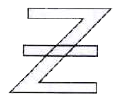On a squared paper, sketch the following:
A hexagon with six lines of symmetry.
To sketch a hexagon with six lines of symmetry on squared paper, follow these steps:
1. Draw a Regular Hexagon:
- Start by drawing a regular hexagon. A regular hexagon has six equal sides and angles. You can do this by marking six points on the squared paper that are equidistant from a central point and then connecting these points with straight lines.
2. Identify the Center:
- Locate the center of the hexagon. This point will be crucial for drawing the lines of symmetry.
3. Draw the First Line of Symmetry (L1):
- Draw a vertical line that passes through the center of the hexagon and divides it into two equal halves. This is your first line of symmetry.
4. Draw the Second Line of Symmetry (L2):
- Now, draw a line that goes from one vertex of the hexagon to the opposite vertex. This line should also pass through the center. This is your second line of symmetry.
5. Draw the Third Line of Symmetry (L3):
- Draw another line that connects the midpoints of two opposite sides of the hexagon. This line should also pass through the center. This is your third line of symmetry.
6. Draw the Fourth Line of Symmetry (L4):
- Repeat the process for the remaining pair of opposite vertices. Draw a line from one vertex to the opposite vertex through the center. This is your fourth line of symmetry.
7. Draw the Fifth Line of Symmetry (L5):
- Again, draw a line connecting the midpoints of the remaining pair of opposite sides. This is your fifth line of symmetry.
8. Draw the Sixth Line of Symmetry (L6):
- Finally, draw the last line of symmetry, which is the last vertex to the opposite vertex, passing through the center. This is your sixth line of symmetry.
Final Drawing:
- You should now have a regular hexagon with six lines of symmetry drawn on your squared paper.
- Start by drawing a regular hexagon. A regular hexagon has six equal sides and angles. You can do this by marking six points on the squared paper that are equidistant from a central point and then connecting these points with straight lines.
- Locate the center of the hexagon. This point will be crucial for drawing the lines of symmetry.
- Draw a vertical line that passes through the center of the hexagon and divides it into two equal halves. This is your first line of symmetry.
- Now, draw a line that goes from one vertex of the hexagon to the opposite vertex. This line should also pass through the center. This is your second line of symmetry.
- Draw another line that connects the midpoints of two opposite sides of the hexagon. This line should also pass through the center. This is your third line of symmetry.
- Repeat the process for the remaining pair of opposite vertices. Draw a line from one vertex to the opposite vertex through the center. This is your fourth line of symmetry.
- Again, draw a line connecting the midpoints of the remaining pair of opposite sides. This is your fifth line of symmetry.
- Finally, draw the last line of symmetry, which is the last vertex to the opposite vertex, passing through the center. This is your sixth line of symmetry.
- You should now have a regular hexagon with six lines of symmetry drawn on your squared paper.
Topper's Solved these Questions
- SYMMETRYBOOK - MTG IIT JEE FOUNDATIONCHAPTER - SYMMETRYEXERCISE - NCERT Section (Exercise 13.3)
10 Videos
- SYMMETRYBOOK - MTG IIT JEE FOUNDATIONCHAPTER - SYMMETRYEXERCISE - Exercise (Multiple Choice Questions) LEVEL - 1
20 Videos
- SYMMETRYBOOK - MTG IIT JEE FOUNDATIONCHAPTER - SYMMETRYEXERCISE - NCERT Section (Exercise 13.1)
16 Videos
- RATIO AND PROPORTIONBOOK - MTG IIT JEE FOUNDATIONCHAPTER - RATIO AND PROPORTIONEXERCISE - OLYMPAID/HOTS CORNER
15 Videos
- UNDERSTANDING ELEMENTARY SHAPES BOOK - MTG IIT JEE FOUNDATIONCHAPTER - UNDERSTANDING ELEMENTARY SHAPES EXERCISE - OLYMPIAD/HOTS CORNER
20 Videos
Similar Questions
Find the number of lines of symmetry in each of the following shapes. How will you check your answers?

View SolutionNumber of line of symmetry in the given figure is

View SolutionList any four symmetrical objects from your home or school.
View SolutionIf 60 is divided into two parts in the ratio 2 : 3, then the difference between those two parts is
View SolutionA polygon has prime number of sides. If number of sides is equal to the sum of the two least consecutive primes. The number of diagonals of the polygon is
View SolutionLines of symmetry of a regular hexagon
View SolutionOn a squared paper, sketch the following: (a) A triangle with a horizontal line of symmetry but no vertical line of symmetry.
View SolutionOn a squared paper, sketch the following: (b) A quadrilateral with both horizontal and vertical lines of symmetry. (Hint : It will be if you first draw the lines of symmetry and then complete the figures.)
View SolutionOn a squared paper, sketch the following: (c) A quadrilateral with a horizontal line of symmetry but no vertical line of symmetry.
View SolutionOn a squared paper, sketch the following: (d) A hexagon with exactly two lines of symmetry. (Hint : It will be if you first draw the lines of symmetry and then complete the figures.)
View SolutionOn a squared paper, sketch the following: (e) A hexagon with six lines of symmetry. (Hint : It will be if you first draw the lines of symmetry and then complete the figures.)
View SolutionDraw the rough sketch of the following:
a. Quadrilateral with no line of symmetry.
b. Hexagon with two lines of symmetry.
View SolutionA regular hexagon has six lines of symmetry.
View SolutionOn a squared paper,sketch the following:
A triangle with a horizontal line of symmetry but no vertical line of symmetry.
View SolutionOn a squared paper,sketch the following:
A quadrilateral with both horizontal and vertical lines of symmetry.
View SolutionOn a squared paper,sketch the following:
A quadrilateral with a horizontal line of symmetry but no vertical line of symmetry.
View Solution
